Ijraset Journal For Research in Applied Science and Engineering Technology
- Home / Ijraset
- On This Page
- Abstract
- Introduction
- Conclusion
- References
- Copyright
Smart Attendance System (Multi-Factor Authentication)
Authors: Malarowthu Pamaja, Paritala Venkata Sai Krishna, Nimmala Narendra Babu, Kakani Niharika, Chintala Jnana Dharanesh
DOI Link: https://doi.org/10.22214/ijraset.2024.60257
Certificate: View Certificate
Abstract
The \\\"SMART Attendance System using Facial and OTP Verification\\\" project aims to revolutionize traditional attendance management processes by integrating advanced biometric technologies. In this project, a sophisticated system is developed to automate attendance tracking using facial recognition and OTP verification methods. The system utilizes computer vision algorithms to accurately identify individuals based on their facial features, ensuring reliable attendance recording. Additionally, OTP verification adds an extra layer of security, enhancing the integrity of the system. The project encompasses the design and implementation of the software and hardware components required for seamless operation. Through this innovative solution, organizations can streamline attendance monitoring, improve efficiency, and mitigate identity fraud. The project not only offers a practical application of emerging technologies but also provides valuable insights into biometric authentication systems\\\' development and deployment.
Introduction
I. INTRODUCTION
SMART ATTENDANCE SYSTEM (MULTI-FACTOR AUTHENTICATION)
Is the project that represents a significant leap forward in modernizing conventional attendance management practices by harnessing the power of cutting-edge biometric technologies. By seamlessly integrating facial recognition and OTP verification methods, this innovative system offers a sophisticated solution for automating attendance tracking processes. Leveraging advanced computer vision algorithms, the system ensures precise identification of individuals based on their unique facial features, thereby guaranteeing accurate attendance recording. Furthermore, the inclusion of OTP verification adds an additional layer of security, bolstering the integrity and reliability of the system.
This project encompasses the comprehensive design and implementation of both software and hardware components necessary for the seamless operation of the SMART Attendance System. Through its adoption, organizations stand to benefit significantly from streamlined attendance monitoring, heightened efficiency, and strengthened defenses against identity fraud. Notably, this project not only serves as a practical demonstration of emerging technologies in action but also offers valuable insights into the development and deployment of sophisticated biometric authentication systems. Overall, the SMART Attendance System represents a groundbreaking advancement in attendance management, promising to revolutionize how organizations approach the task of tracking and recording attendance.
II. LITERATURE SURVEY
- "A Review of Biometric Attendance System"
Authors: Aysha Mohammed, Dr. K. D. Kulat, Dr. S. K. Gaikwad
Published In: International Journal of Scientific and Research Publications (IJSRP)
Year: 2016
This survey provides an overview of various biometric technologies used in attendance systems, including fingerprint, iris, and facial recognition. It discusses the advantages, limitations, and challenges associated with each technology and compares different systems based on accuracy, reliability, and scalability.
2. "A Review of Facial Recognition Techniques"
Authors: Ayushi Vyas, Gaurav Kumar Pandey, Bhavna Soni
Published In: International Journal of Advanced Research in Computer Science and Software Engineering (IJARCSSE)
Year: 2019
This survey focuses specifically on facial recognition techniques, covering both traditional methods and deep learning-based approaches. It discusses the evolution of facial recognition technology, its applications, challenges such as occlusion and illumination variations, and recent advancements in deep learning models for improved accuracy.
3. "A Review on the Implementation of OTP (One Time Password) Based Secure Authentication"
Authors: Deepak Kumar, Parul Goyal
Published In: International Journal of Computer Applications (IJCA)
Year: 2016
This survey examines the implementation of OTP-based authentication methods in various systems, including online banking, e-commerce, and access control. It discusses different OTP generation techniques, security considerations, usability issues, and future research directions.
4. "Biometric-Based Attendance System: A Comprehensive Review"
Authors: A. Ghazali, A. Hussain, S. Khatoon
Published In: 2017 IEEE Conference on Systems, Process and Control (ICSPC)
Year: 2017
This paper provides a comprehensive review of biometric-based attendance systems, focusing on fingerprint, iris, palmprint, and facial recognition technologies. It discusses the hardware and software components, integration challenges, security concerns, and potential applications in educational institutions and workplaces.
5. "A Survey on Biometric Recognition Methods"
Authors: Arijit Chakrabarty, Indranil Bose, Ayan Seal
Published In: International Journal of Computer Applications (IJCA)
Year: 2015
This survey presents an overview of various biometric recognition methods, including fingerprint, iris, palmprint, hand geometry, and facial recognition. It discusses the principles behind each method, their advantages and limitations, performance evaluation metrics, and emerging trends in biometric research.
III. ANALYSIS
A. Existing System
The existing attendance management systems vary widely across organizations and industries, but they typically fall into one of several categories:
- Manual Systems: These systems rely on paper-based methods for attendance tracking, where employees sign in on paper registers or timecards. This method is prone to errors, such as illegible handwriting or misplaced records, and can be easily manipulated.
- Barcode or RFID Systems: Some organizations use barcode or RFID (Radio Frequency Identification) technology to automate attendance tracking. Employees are provided with ID cards or badges containing barcodes or RFID tags, which they scan upon entry to record their attendance. While more efficient than manual methods, these systems can still be susceptible to issues such as lost or stolen cards.
- Biometric Systems: Biometric attendance systems utilize physiological or behavioral characteristics to identify individuals. Common biometric modalities include fingerprint recognition, iris scanning, and facial recognition. These systems offer a high level of accuracy and security, but may require significant initial investment and can encounter challenges related to privacy concerns and user acceptance.
- Software-based Systems: Many organizations utilize software applications for attendance tracking, either as standalone solutions or as part of larger HR management systems. These systems typically offer features such as automated attendance recording, reporting, and integration with payroll systems. However, they may lack advanced security features such as biometric authentication.
- Online Time and Attendance Tracking Tools: With the rise of remote work and flexible schedules, online time and attendance tracking tools have become increasingly popular.
These cloud-based platforms allow employees to log their hours and attendance remotely through web or mobile interfaces. While convenient and accessible, these systems may lack the robust security measures of on-premises biometric solutions.
In summary, the existing attendance management systems range from manual paper-based methods to advanced biometric and software-based solutions. Each approach has its own advantages and limitations, and organizations must carefully consider their specific requirements and constraints when selecting a system. The "SMART Attendance System using Facial and OTP Verification" project seeks to address the limitations of existing systems by offering a modern, accurate, and secure solution that leverages facial recognition and OTP verification technologies.
B. Proposed System
The proposed "SMART Attendance System using Facial and OTP Verification" offers a modern, accurate, and secure solution to address the limitations of existing attendance management systems. This system integrates advanced biometric technologies with OTP verification to ensure precise identification of individuals and enhance security measures. Here's an overview of the proposed system:
- Facial Recognition Module
Utilizes advanced computer vision algorithms to analyze unique facial features and accurately identify individuals.
Captures facial images through designated cameras installed at entry points or designated areas within the organization.
Compares captured facial images with pre-registered templates stored in a secure database to verify the identity of employees.
2. OTP Verification:
Generates one-time passwords (OTPs) and sends them to employees' registered mobile devices via SMS or email.
Employees are required to input the received OTP along with their facial recognition to mark their attendance.
Adds an additional layer of security to prevent unauthorized access and identity fraud.
3. User Interface:
Provides a user-friendly interface for employees to mark their attendance using facial recognition and OTP verification.
Allows administrators to monitor attendance records in real-time, view reports, and manage user permissions.
Supports integration with existing HR management systems for seamless data exchange and reporting.
C. Feasibility Description
A feasibility study of a smart attendance system would typically involve assessing various aspects to determine the viability and practicality of implementing such a system. Key components of the feasibility study may include:
- Technical Feasibility: Evaluate the technical capabilities and requirements needed to develop and implement the smart attendance system. Consider factors such as hardware and software infrastructure, compatibility with existing systems, and availability of necessary technology.
- Operational Feasibility: Assess how the smart attendance system will integrate into existing operational processes and workflows. Determine if it will be easy to use and manage by administrators, teachers, or employees, and evaluate any potential disruptions to daily operations during implementation.
- Financial Feasibility: Conduct a cost-benefit analysis to determine the financial feasibility of the smart attendance system. Estimate the initial investment required for development, implementation, and training, as well as ongoing maintenance and support costs. Compare these costs to the potential benefits, such as time savings, improved accuracy, and reduced administrative workload.
- Legal and Regulatory Feasibility: Evaluate the legal and regulatory requirements that may impact the implementation of the smart attendance system. Consider data privacy laws, security regulations, and any other legal considerations related to collecting, storing, and managing attendance data.
- Organizational Feasibility: Assess the readiness and willingness of the organization to adopt the smart attendance system. Consider factors such as organizational culture, leadership support, and staff attitudes towards technology adoption. Identify any potential barriers or challenges that may hinder successful implementation.
- Schedule Feasibility: Develop a realistic timeline for the implementation of the smart attendance system. Consider factors such as development time, testing phases, training sessions, and rollout plans. Ensure that the proposed schedule aligns with organizational priorities and resource availability.
- Risk Analysis: Identify potential risks and uncertainties associated with implementing the smart attendance system. Assess the likelihood and impact of these risks and develop mitigation strategies to address them effectively
IV. MODULE DESCRIPTION
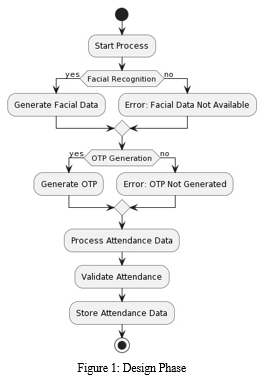
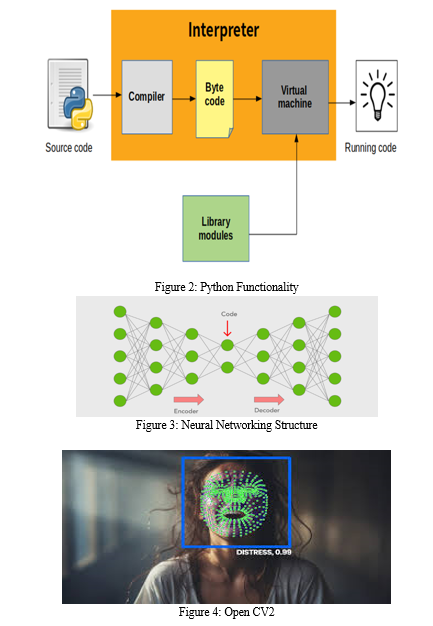
V. IMPLEMENTATION & TESTING
Implementation and testing of "Emotion Symphony: A deep learning journey through human facial emotions" would involve several steps:
A. Face Recognition Setup:
- Install OpenCV and a face recognition library like dlib or OpenCV's built-in face recognition module.
- Train the face recognition model on a dataset of known faces to recognize individuals accurately.
B. OTP Generation and Verification:
- Generate a random OTP (One-Time Password) for each attendance session.
- Use Python's random module to generate OTPs and store them securely.
C. Email Integration:
- Use Python's smtplib library to send emails.
- Set up an SMTP server for sending emails. You can use Gmail's SMTP server for this purpose.
- Authenticate with the SMTP server using your credentials.
D. Integration of Face Recognition, OTP, and Email:
- When a person attempts to mark attendance, prompt them to verify their identity through face recognition.
- Once their identity is confirmed, prompt them to enter the OTP received via email.
- Compare the entered OTP with the generated OTP to verify attendance.
E. Logging and Reporting:
- Log attendance records, including the date, time, and identity of the individual.
- Generate reports .
F. Testing:
- Test the system thoroughly to ensure accuracy in face recognition, OTP generation, email delivery, and attendance verification.
- Test different scenarios, such as valid and invalid faces, correct and incorrect OTPs, network failures, etc.
G. Test Cases:
Test cases for the Image Caption Generator project aim to verify the functionality and performance of the system in generating accurate and contextually relevant captions for input images.
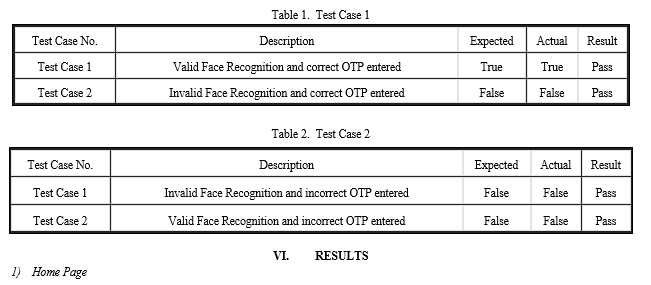
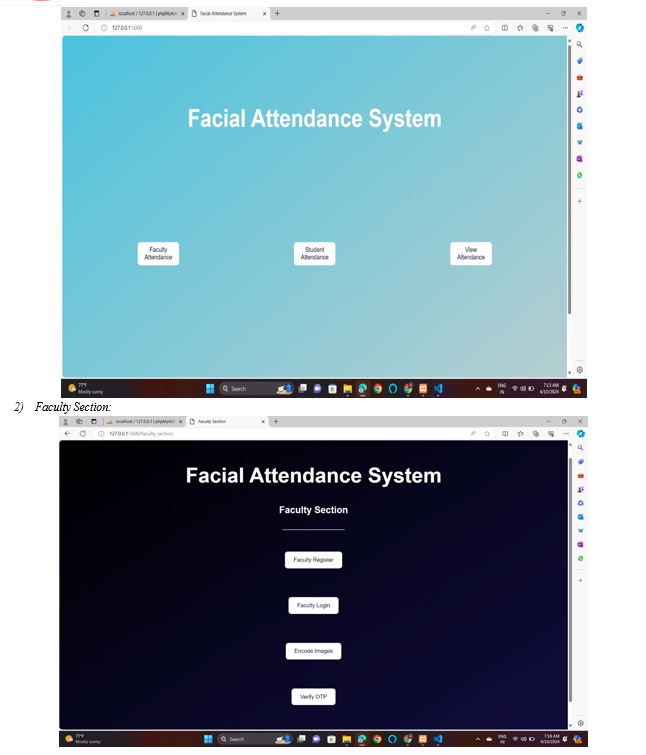
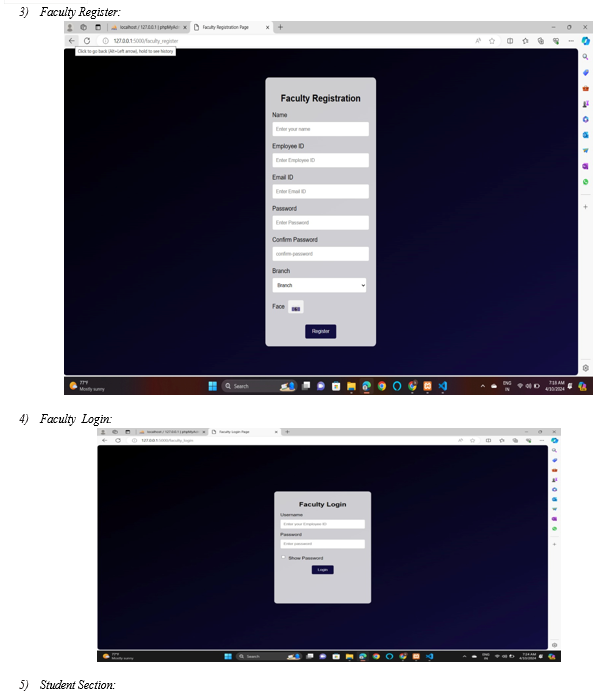
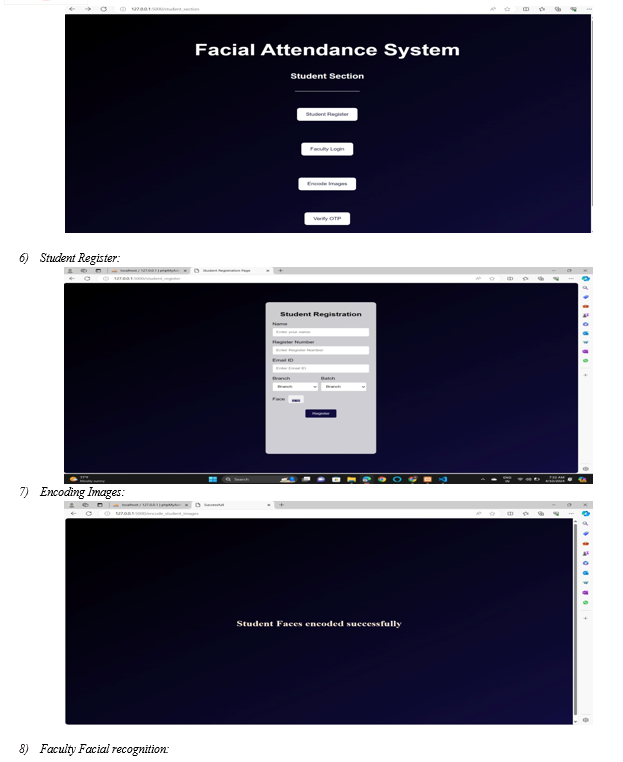



Conclusion
The \\\"SMART Attendance System using Facial and OTP Verification\\\" project lays a solid foundation for modernizing attendance tracking processes and enhancing security measures within organizations. Here are some potential future scope areas for further improvement and expansion of the project: 1) Enhanced Facial Recognition Capabilities: Explore advanced facial recognition algorithms and technologies to improve accuracy, speed, and robustness. Incorporate features such as emotion detection, age estimation, and gender recognition for additional insights and functionalities. 2) Integration with Biometric Devices: Integrate the attendance system with biometric devices such as fingerprint scanners or iris scanners for multi-modal biometric authentication. Provide flexibility for employees to choose their preferred biometric modality for attendance marking. 3) Mobile Application Development: Develop dedicated mobile applications for both employees and administrators to access the attendance system on the go. Provide features such as push notifications, GPS-based attendance marking, and offline mode for seamless user experience. 4) Real-time Analytics and Insights: Implement real-time analytics and reporting capabilities to monitor attendance trends, identify patterns, and generate actionable insights. Enable administrators to make data-driven decisions for workforce management, resource allocation, and performance evaluation. 5) Automation and Integration with HR Systems: Automate attendance-related workflows and processes, such as leave management, shift scheduling, and payroll processing. Integrate the attendance system with existing HR management software for seamless data exchange and workflow integration. 6) Enhanced Security Features: Implement additional security measures such as multi-factor authentication, encryption of sensitive data at rest and in transit, and intrusion detection systems. Conduct regular security audits and vulnerability assessments to identify and mitigate potential security risks. 7) Scalability and Cloud Migration: Design the system to be scalable and cloud-native, allowing for easy expansion and adaptation to growing organizational needs. Migrate the system to a cloud-based infrastructure for improved flexibility, scalability, and cost-effectiveness. 8) User Experience (UX) Improvements: Continuously gather user feedback and conduct usability studies to identify areas for UX improvement. Enhance the user interface design, navigation flow, and accessibility features to ensure a seamless and intuitive user experience. 9) Compliance with Regulatory Requirements: Ensure compliance with relevant data protection regulations such as GDPR, HIPAA, or CCPA. Implement features for data anonymization, consent management, and audit trail logging to meet regulatory requirements. 10) Machine Learning and AI Integration: Explore the use of machine learning and artificial intelligence techniques for predictive analytics, anomaly detection, and personalized user experiences. Leverage AI-based algorithms to optimize attendance tracking processes and identify opportunities for efficiency gains. By focusing on these future scope areas, the \\\"SMART Attendance System using Facial and OTP Verification\\\" project can continue to evolve and provide value-added features to organizations, ultimately contributing to improved workforce management, security, and operational efficiency. In conclusion, the \\\"SMART Attendance System using Facial and OTP Verification\\\" project presents a comprehensive solution for modernizing attendance tracking processes and enhancing security measures within organizations. By leveraging facial recognition technology and one-time password (OTP) verification, the system provides a reliable, efficient, and secure method for employees to mark their attendance. Throughout the project, various technologies such as OpenCV for facial recognition, machine learning frameworks like TensorFlow or PyTorch, web development frameworks such as Django or Flask, and database management systems like MySQL or PostgreSQL are utilized to implement the system\\\'s functionalities. Additionally, adherence to non-functional requirements such as performance, reliability, security, usability, scalability, and compliance with regulatory standards ensures that the system meets high-quality standards and addresses the diverse needs of organizations. The future scope of the project encompasses areas such as enhanced facial recognition capabilities, integration with biometric devices, development of mobile applications, real-time analytics and insights, automation and integration with HR systems, scalability and cloud migration, user experience improvements, compliance with regulatory requirements, and integration of machine learning and AI techniques. These future developments will further enhance the system\\\'s functionality, usability, and value proposition for organizations seeking efficient and secure attendance tracking solutions. Overall, the \\\"SMART Attendance System using Facial and OTP Verification\\\" project represents a significant advancement in workforce management technology, offering organizations a modern, accurate, and secure solution for attendance tracking that aligns with the evolving needs of the digital age. Through continuous innovation and adaptation to emerging technologies and user requirements, the system has the potential to drive efficiency, productivity, and compliance across various industries and organizational settings.
References
[1] Jain, A.K., Ross, A., & Nandakumar, K. (2016). Introduction to Biometrics. Springer. [2] Turk, M., & Pentland, A. (1991). Face recognition using eigenfaces. Proceedings of IEEE Computer Society Conference on Computer Vision and Pattern Recognition. [3] Ramanathan, R., & Chellappa, R. (2005). Face verification across age progression. Proceedings of IEEE International Conference on Computer Vision. [4] Gonzalez, R.C., & Woods, R.E. (2018). Digital Image Processing. Pearson Education. [5] Haykin, S. (2009). Neural Networks and Learning Machines. Pearson Education. [6] Buczak, A.L., & Guven, E. (2016). A survey of data mining and machine learning methods for cyber security intrusion detection. IEEE Communications Surveys & Tutorials, 18(2), 1153-1176. [7] Stallings, W. (2017). Cryptography and Network Security: Principles and Practices. Pearson Education. [8] Press, W.H., Teukolsky, S.A., Vetterling, W.T., & Flannery, B.P. (2007). Numerical Recipes: The Art of Scientific Computing. Cambridge University Press. [9] Jain, A., Nandakumar, K., & Ross, A. (2016). 50 years of biometric research: Accomplishments, challenges, and opportunities. Pattern Recognition Letters, 79, 80-105. [10] Kumar, N., & Vyas, O. P. (2019). A Review on Face Recognition Techniques, Methods, and Its Applications. International Journal of Advanced Research in Computer Science, 10(2), 160-163. [11] Jain, A. K., & Ross, A. (2012). Handbook of Biometrics. Springer Science & Business Media. [12] Hu, J., Lu, J., & Tan, Y. (2017). Face Recognition in Smart Attendance System Using Internet of Things. Procedia Computer Science, 110, 353-359. [13] Baur, C., Cheng, H., & Leandro, J. (2018). Improving Facial Recognition with Deep Learning. International Journal of Computer Applications, 181(48), 19-24. [14] Jain, A. K., & Dass, S. C. (2018). Handbook of Biometrics for Forensic Science. Springer. [15] Singh, V., & Kaur, K. (2018). Biometric Authentication and Privacy Concerns. Procedia Computer Science, 132, 897-904.
Copyright
Copyright © 2024 Malarowthu Pamaja, Paritala Venkata Sai Krishna, Nimmala Narendra Babu, Kakani Niharika, Chintala Jnana Dharanesh. This is an open access article distributed under the Creative Commons Attribution License, which permits unrestricted use, distribution, and reproduction in any medium, provided the original work is properly cited.

Download Paper
Paper Id : IJRASET60257
Publish Date : 2024-04-13
ISSN : 2321-9653
Publisher Name : IJRASET
DOI Link : Click Here
 Submit Paper Online
Submit Paper Online

